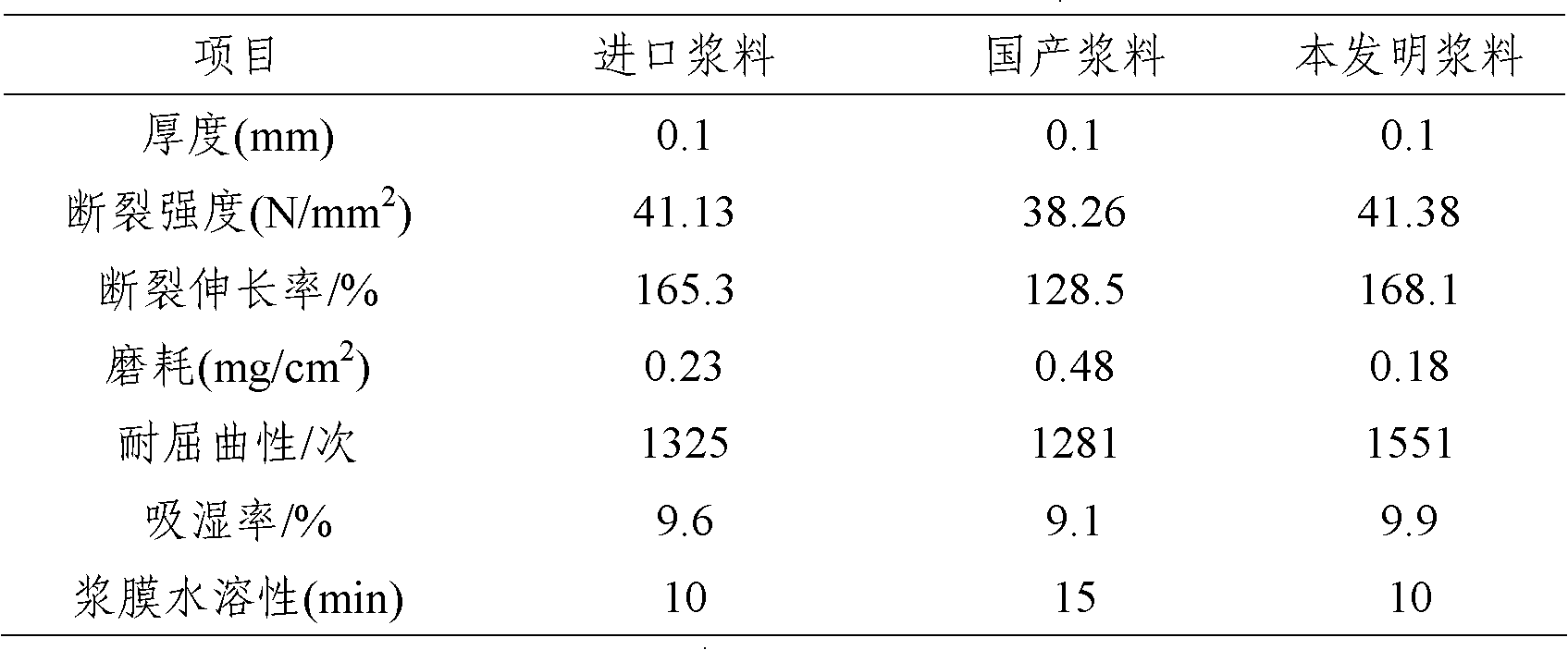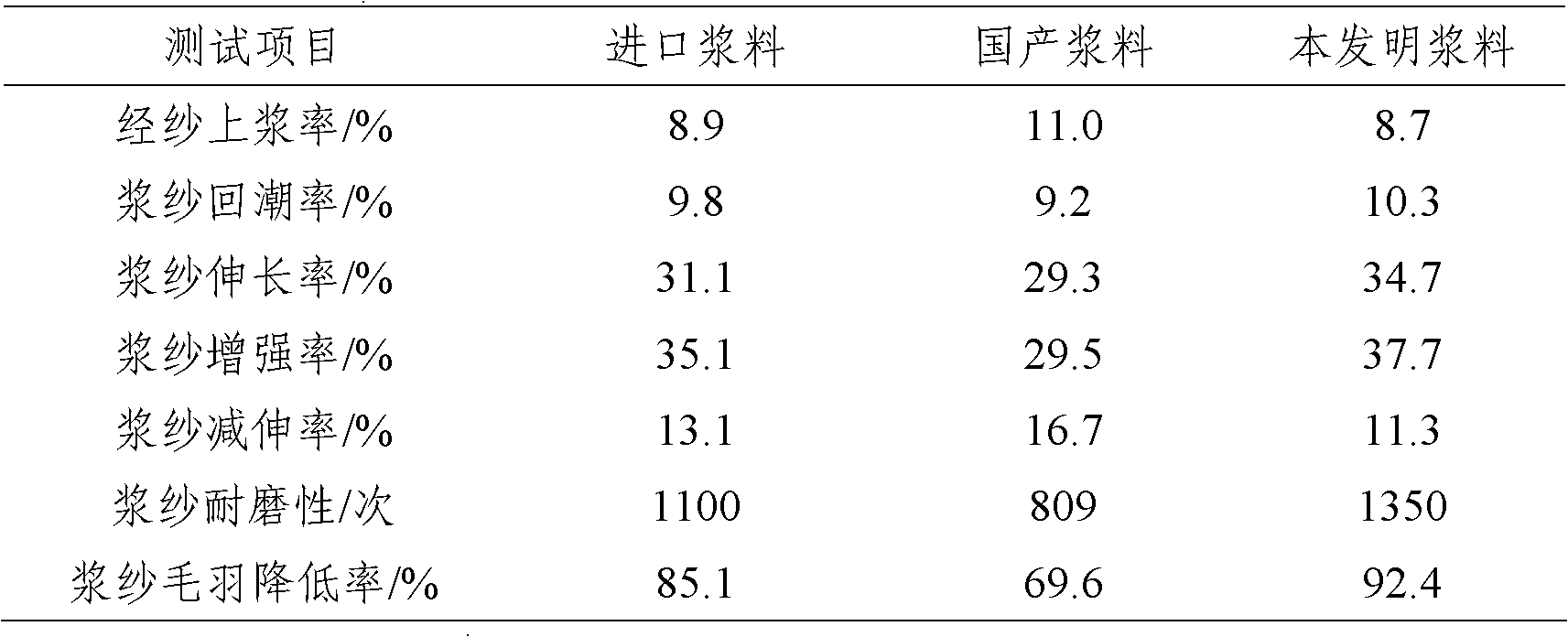Textile size combination
A technology of textile pulp and composition, applied in textiles, papermaking, fiber treatment, etc., can solve problems such as not providing a complete solution, and achieve the effects of improving textile efficiency, good wear resistance, and easy desizing
- Summary
- Abstract
- Description
- Claims
- Application Information
AI Technical Summary
Problems solved by technology
Method used
Image
Examples
Embodiment 1
[0027] (1) Preparation of solid acrylate:
[0028] Put 70kg of acrylonitrile in a 500L reaction kettle, add 14kg of 10% sodium hydroxide solution, stir at room temperature for 1 hour, use cooling water to cool down during the stirring process, transfer to a liquid separator to remove the sodium hydroxide solution, and then use 100L saturated saline Wash twice, transfer to a 1000L high-level tank (or reactor) with stirring; 250kg methyl acrylate, 230kg butyl acrylate, and 100kg methyl methacrylate are sequentially distilled to remove the polymerization inhibitor, and transferred to the above-mentioned high-level tank Add 150kg of acrylic acid, 100kg of methacrylic acid, and 100kg of acrylamide to the head tank and stir evenly for subsequent use;
[0029] Add 200kg of toluene, 200kg of cyclohexane, and 100kg of absolute ethanol into a 1000L overhead tank with stirring and mix well. Take by weighing 5.6kg of benzoyl peroxide and 2.4kg of azobisisobutyronitrile and drop into the ...
Embodiment 2
[0036] (1) Preparation of solid acrylate:
[0037] Put 140kg of acrylonitrile in a 500L reaction kettle, add 28kg of 10% sodium hydroxide solution, stir at room temperature for 1 hour, use cooling water to cool down during the stirring process, transfer to a liquid separator to remove the remaining sodium hydroxide solution, and then use 200L Wash twice with saturated brine, and transfer to a 2000L high-level tank (or reactor) with stirring; 500kg methyl acrylate, 460kg butyl acrylate, and 200kg methyl methacrylate are successively distilled to remove the polymerization inhibitor, and transferred to the above-mentioned In the head tank; then add 300kg acrylic acid, 200kg methacrylic acid and 200kg acrylamide to the head tank and stir evenly for later use;
[0038] Add 400kg of toluene, 400kg of cyclohexane, and 200kg of absolute ethanol into a 2000L overhead tank with stirring and mix well. Take by weighing 11.2kg of benzoyl peroxide and 4.8kg of azobisisobutyronitrile and dr...
Embodiment 3
[0045] (1) Preparation of solid acrylate:
[0046] Mix and stir the seven monomers of acrylonitrile, methyl acrylate, butyl acrylate, methyl methacrylate, acrylic acid, methacrylic acid and acrylamide in a mass ratio of 7:25:23:10:15:10:10, spare;
[0047] Xylene or toluene, hexane, and absolute ethanol are mixed uniformly in a mass ratio of 2:2:1 as a reaction solvent, and set aside;
[0048] Benzoyl peroxide and azobisisobutyronitrile are mixed evenly according to the mass ratio of 7: 3 as a composite initiator, and its consumption is 0.8% of the total mass of the monomers, and the mixed reaction solvent is added, and the consumption of the reaction solvent is a unit 50% of the total weight of the body, stir evenly, and set aside;
[0049] In the reaction kettle equipped with a reflux condenser, add a reaction solvent 3.5 times the total mass of the monomers, add 0.01% n-dodecanethiol of the total mass of the monomers as a chain transfer agent, heat up to 95 ° C, and prepa...
PUM
| Property | Measurement | Unit |
|---|---|---|
| glass transition temperature | aaaaa | aaaaa |
| modulus | aaaaa | aaaaa |
Abstract
Description
Claims
Application Information
 Login to View More
Login to View More - R&D
- Intellectual Property
- Life Sciences
- Materials
- Tech Scout
- Unparalleled Data Quality
- Higher Quality Content
- 60% Fewer Hallucinations
Browse by: Latest US Patents, China's latest patents, Technical Efficacy Thesaurus, Application Domain, Technology Topic, Popular Technical Reports.
© 2025 PatSnap. All rights reserved.Legal|Privacy policy|Modern Slavery Act Transparency Statement|Sitemap|About US| Contact US: help@patsnap.com



